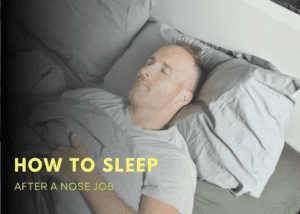With back pain being so common, is there a sleeping position that will give me relief from the nagging pain in my back?
It depends on what is causing your back pain. If your back pain is muscular, you can adopt a sleeping position such as the fetal position. Bringing your legs up towards your chest while sleeping on your side can take the tension of back muscles.
If you’re experiencing lower back pain and having difficulty sleeping, there are a few strategies you can try to help you get a better night’s rest:
- Use a supportive mattress: A mattress that is too soft or too firm can exacerbate back pain. Consider investing in a medium-firm mattress or a memory foam mattress that provides support and helps to alleviate pressure on the lower back.
- Place a pillow between your knees: If you sleep on your side, placing a pillow between your knees can help to align your spine and reduce strain on your lower back.
- Sleep on your back: Lying on your back with a pillow under your knees can help to reduce stress on the lower back.
- Avoid sleeping on your stomach: Sleeping on your stomach can put unnecessary strain on your lower back and may exacerbate pain.
- Use a lumbar roll: A lumbar roll is a small, cylindrical pillow that you can place behind your lower back for added support while sleeping.
- Try warm or cold therapy: Applying a warm or cold compress to the lower back can help to reduce pain and inflammation.
- Stretch before bed: Gently stretching the muscles in your lower back before bed can help to alleviate tension and improve sleep.
In addition to these strategies, it’s important to address any underlying causes of lower back pain, such as muscle strains or injuries, and work with a healthcare professional to develop a treatment plan. Getting proper rest and managing the pain can help you sleep more comfortably and improve your overall quality of life.
Should you sleep on the floor with lower back pain
Sleeping on the floor with lower back pain may not be the most comfortable or practical solution, and there is no evidence to suggest that it is more beneficial than sleeping on a supportive surface such as a mattress. In fact, sleeping on a hard surface such as the floor may actually increase the risk of developing pressure ulcers or sore spots on the skin.
It’s important to remember that the best sleeping position for lower back pain will depend on the individual and the underlying cause of the pain. It may be helpful to speak with a healthcare professional or a physical therapist to determine the most appropriate sleep position for your needs.
How to get a better nights sleep with lower back pain
There are many ways to sleep with lower back pain; you need to find the position that gives the most relief from your pain.
Lower back pain can be muscular, and as such, you need to find a way to sleep with lower back pain so you can sleep well and wake refreshed.
Before you jump into bed, have a warm bath to help your muscles relax. If your lower back muscles are in spasm, a warm bath and massage may provide some relief.
Tackle your pain medication and gently stretch out your muscles if not too painful. Sit on the side of the bed and support your torso with an arm on the mattress, and lay down in one motion if you can.
Sleep on your side with your knees slightly bent towards your torso. Place a pillow between your knees, and this will support your pelvis and hips while you sleep.
The idea is to place your spine in a neutral position to take the strain of your lower back muscles.
How to sleep with a herniated disk
Sleep on your side and lift your legs towards your chest. This is called the fetal position, which is adopted from how growing babies sleep in the womb.
The fetal position is the best option for how to sleep with a herniated disk. Due to the spine being in an open posture, you may be able to get some pain relief in this position.
By having an open posture, your pain should be relieved as the passage containing the nerves is not being restricted. You may wish to swap from side to side to prevent any imbalances.
Finding a way of sleeping with lower back pain can be trial and error, and if you have not consulted your doctor or chiropractor, you should experiment to find what gives you the most relief from back pain.
You can sleep on your back if you have lower back pain and it can offer relief, however, try placing a couple of pillows under your knees; this will take the pressure off your back muscles and force your lower back to lay flat against the mattress.
Sleeping in the prone position or on your tummy can offer relief for back pain. You will need to place a pillow under your pelvis to release tension.
Caution should be taken when sleeping in the prone position. You may get pain relief from your back problem, but you could inadvertently create a problem in your cervical spine due to your neck’s unnatural position.

How to sleep after a chiropractic adjustment
Sleep on your back. Your chiropractor will have made some slight adjustments to your spine, so you will be best to sleep in a flat position on your back until the adjustments have worked and you feel relief.
Sleep on your back with enough support for your head and neck, keep your back flat against the mattress if possible. For extra comfort, put one or two pillows under your knees. This will force the small of your back onto the mattress and reduce muscle tension.
How should I sleep after lower back adjustment?
On your back with a pillow under your head and neck and a pillow under your knees, your chiropractor may advise sleeping with a rolled towel under your lower back to maintain the curvature of your spine.
Does a mattress cause back pain?
If your mattress is worn and has seen better days, your mattress can cause poor posture while sleeping and cause considerable pain in your back.
If you have back pain and your mattress is old, replace it with a new mattress, preferably a memory foam mattress that will adjust and support your curves while you sleep soundly through the night.
Differences between lower and upper back pain
Lower back pain and upper back pain are two common types of back pain that can have a variety of causes.
Lower back pain is pain that occurs in the lower back region, often between the bottom of the ribcage and the top of the buttocks. It can be caused by a variety of factors, including muscle strains, herniated discs, and osteoarthritis. Lower back pain can range from mild to severe and may be accompanied by other symptoms such as numbness, tingling, and weakness in the legs.
Upper back pain is pain that occurs in the upper back region, between the base of the neck and the bottom of the ribcage. It can be caused by muscle strains, poor posture, and injuries such as whiplash. Upper back pain may also be a result of underlying medical conditions such as scoliosis or osteoporosis. Like lower back pain, upper back pain can range from mild to severe and may be accompanied by other symptoms such as difficulty moving the neck or arms.
Overall, lower back pain and upper back pain can have similar causes and symptoms, but they occur in different regions of the back. Treatment for back pain may include rest, physical therapy, medication, and in some cases, surgery. It’s important to speak with a healthcare professional to determine the cause of the back pain and develop a treatment plan that is appropriate for your specific needs.





